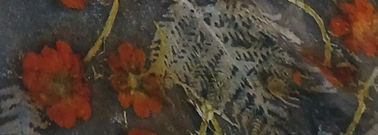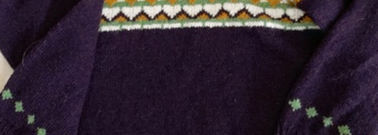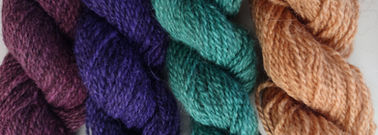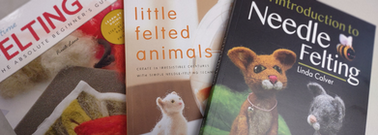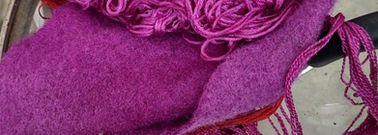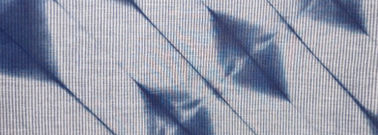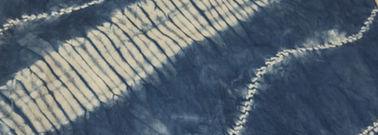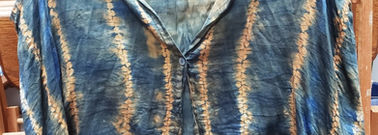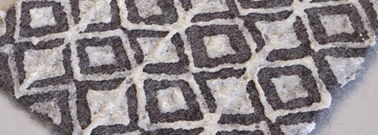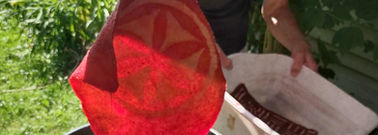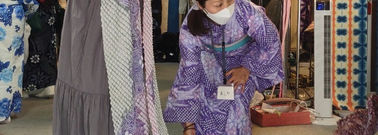Gallery
As we have new class photos, fun new show and tell ourselves, or special projects our customers bring in to share, we'll post them here!
Intro to Felt
Mar 25th
I missed class on Saturday, but my sister Robin who has taught felting, spinning and all about silk all over the country filled in for me, so I know the participants had a great time and learned a lot!
One of the attendees sent me a photo of the last three knitting accessory pouch (or whatever they end up using them for!) which they made in class to learn how to work around a resist and to have some fun playing with embellishments and starting to learn how colors interact when felted (its quite different than knitting, spinning or weaving!).
I'm sorry to have missed seeing the other accomplishments from class, but these three look great! Most importantly from my standpoint as a teacher, they don't appear to have holes or bulges and are fully felted and "suitable to the intended use" so they won't wear out or fall apart (so much felt I see out there is not fully felted and so wears poorly and gives felt a bad rap).
A study of color...and gauge!
Mar 4th
The two garments shown in the gallery here are the exact same yarn and pattern. But I chose the gold, charcoal and teal colors and gave the project to Chris to work on between customers, not realizing the manufacturer was going to send me a model! So when the pink/charcoal/blue model arrived in the same yarn and pattern, at first I was bummed to have a duplication. But then I realized it might be helpful to have both garments in the shop by way of illustrating how differently a project can look based on color choices. AND....what a difference gauge can make (since the model the manufacturer sent is knit at a tighter gauge than Chris is working at!
So having both here is interesting and instructive - so stop by and have a closer look! There isn't a right or wrong here - just an illustration of different choices about color and gauge!
I believe that Chris finished the gold model, but I only have a photo of the WIP (work in progress) to show right now.
Clark Institute Tapestry Exhibit
Feb 11th
The Clark Institute in Williamstown MA is hosting an exhibit of modern tapestries thru March 6th. A friend and I went on Saturday - if you have a chance, it is not to be missed. I honestly knew nothing about modern tapestry, the involvement of Matisse, Picasso, Miro, etc in it, or the impact the industry had during the 20th century on raising women's role in this art form. A professor from U Wisc. gave a talk about it on saturday which was fascinating. And the Clark has an impressive hold of Winslow Homers, Renoirs, and an AMAZING Remington painting of horses, to highlight just a small bit of what they have in their regular collection So you could really make a very full day of it.
Like nachos....you can't just knit 1!
Oct 16th
This Freia Squares hat has been a hit at the shop. It looks more complicated than it is, so even if you are looking for a mindless project, this can fit the bill for easy project and yet really knock your socks off as far as impact goes!
No two are alike and the only trouble is deciding which 2 Freia Minis to put together! That's why several customers have come back for seconds!
Sorry I don't have space in this website to add this product online, but this eye popping basket of colors is at the shop and the pattern is free with the yarn purchase. So come on by and pick up one or two to add to your holiday gift knitting!
Inspired by foliage?
Oct 16th
If you live here in New England, you probably love the change of seasons. I love each season for what it offers, but the colors of fall are what resonate with me most. Every day I walk Winnie I find leaves I am in awe of - even this year where foliage was not as spectacular as usual and certainly came later! This morning, it was this set of leaves - I'm not even sure what type of tree they fell from, but I was astonished to see the range of colors in them since I've always thought it was only the sugar maples that yielded the great range. Anyway,after picking up the single leaf last week and looking at yarns afterwards and then this range of leaves today and looking at yarns, it seems like The Fiber Co yarns and Mirasol's Llama Hasa cover the autumnal colors really well. So if you're looking to knit something inspired by autumn leaves, come in and check out Lore, Cumbria, Llama Hasa and Alpaca Classic!
Pot Holder Looms & Loops!
Sept 17th
I just washed a bunch of pot holders that I was gifted by various family members over the years and was struck by how well they've held up!
We have both the Pro size, as well as the Traditional size, potholder looms in stock. And we have a LOT of bags of cotton loops - from multi colored bags to solid bags that would likely cover just about any/every holiday as well as a range of kitchen decors! The looms are always a popular holiday gift, but why not pick up a loom today and make the actual potholders the gift this year! With so many colors of oops to choose from, you could have a lot of fun exploring different weaving designs!
K1P1 hat!
Sept 17th
I've knit a lot of hats over the (ahem) 44 years I've been knitting. I love them for exploring different styles, sitches, depths, brims, etc but think I have finally decided that I just really like a deep (so the depth comes down below my lower earlobe), double folded at the brim, K1P1 hat! And I like it knit on a much smaller needle than the yarn calls for so it is extra cushy and warm.
It seems so "vanilla" when there are so many fun and more interesting stitches to play with, so I'm kind of embarrassed to admit this realization even to myself! But it is what I like best on my head, so I'll have to leave the fun stitches and patterns to mittens, cowls, sweaters, etc!
A K1P1 hat fits well, (and snuggly, which I like since nothing bothers me more than a hat that moves around on my head - aargh!), it offers a lot of "stretch" so it can accommodate a range of head sizes/hair styles (including my barettes), and it is the warmest with it's extra fold at the brim providing extra protection for the ears and forehead.
I knit this one using a ball of the newest arrival at the shop, Colorspun by Jody Long. Machine washable, soft, lambswool/acrylic blend.
My runner up for fit is the garter stitch, short row shaped, Paper Bag Hat that is a free download from the Manos website. I guess I'll always be alternating between these two hats in the future. Both simple and sort of "unexciting" but really good fitting.
Silk Paper Origami Credit Card Holder
Aug 21st
I was so disappointed that the Silk Paper making class didn't garner enough interest to run earlier this month. I love having pieces of silk paper around to stitch on, bind note books with, and now.....fold into hearty and handy credit card holders!
But they are also great for notecards, wedding invitations, wall art and , I've even had some interior designers use the process to make lampshades for their clients!
Anyway, my friends and I started off the day binding notebooks, making folders and folding some credit card holders to help me use up some lovely papers I had. And this morphed into me switching over to using some sheets of handmade, 100% tussah silk paper (with reeled silk for embellishment) papers that I had laying around.
Botanical Printing - Show & Tell
Aug 14th
Here are a few of the prints from the 3 day workshop here over the weekend. Each participant printed 6 small samples to learn about the different mordants and tannins. Then they printed 3 larger samples striving for more aesthetic layout and to hone their wrapping technique. And finally they printed one large piece using natural dyes to add additional color to the background...and while that steamed they had a chance to over dye a couple pieces from the first days in indigo or another natural dye. So there were 30 prints altogether from the class so I obviously couldn't share them all here, but at least this gives you an idea of what participants did while learning this technique.
Natural Dye Class - Show & Tell
July 23rd...
Wanted to share some photos from the rsults of the last Natural Dye class here this past Saturday. Despite having fewer participants in this class (and more participants allows for more colors to be dyed) we were able to achieve a great range of colors from the garden, kitchen table, ny brother's wood working sawdusts and my travels afar!
And after all the sample skeins were dyed so each participant left with a great reference notebook with colors and formulas, everyone dyed something of their own - yarn to knit or crochet, fiber, rug hooking wool, etc.
And there was still dye left, so on Sunday I threw a cotton summer top into a pot that I'd made up from combining what was left of annato, safflower, osage orange and onion skins. It feels like I have a brand new garment!
Mitzi Show & Tell
July 30th
Mitzi wields some of the fastest needles in the east! And she is always changing up her projects - from thrummed mittens to summer tops with lace panels to fair isle/stranded knitting patterns. And her family is lucky that she loves to work with really nice yarns - they are all outfitted in a range of Fiber Company yarns as well as some lovely alpaca, cashmere and merino blends by other brands. This latest is knit using VIP fingering (7 sts/inch) merino/cashmere blend from the quality Lana Gatto mill in Italy!
Dip Day Show & Tell!
Apr 30th....
I invited the participants of last summer's two shibori classes here to come back for a free "dip day" so they could use my freshly recharged indigo vat to dye any shibori pieces they may have worked on over the winter months.
Quite a few participants were away for school vacation, one was very involved in the weekend's Quilt Show in Essex and several were from out of state anyway and weren't going to fly back here for a day! So only 3 participants were able to avail themselves of the opportunity. But what great shibori's they did! And the three had a lot of fun catching up, comparing notes and dyeing all day!
Here are some of the results from the day.....from shibori on a pre-existing garment to shibori on fabric swatches to be incorporated into some other project and from overdying a previously sewn (and sashiko'd) bag and it's lining (commercial handles bled when the bag was washed it) to simply overdyeing some "experiments" to "see what happens".....lots of successes and learning!
"Treasure"
Apr 9th....
Paka is the Quechuan word for "treasure" - that's how this lovely new pima cotton yarn by Mirasol got its name, Pima Paka!
Peru's climate is ideal for growing cotton - lots of sun, seasonal rainfall and fertile soil! Historically, Peru grew many colors of cotton - brown, green, blue and even pink! Today the lovely white pima is the largest crop of cottons grown in the coastal valleys. The cotton flower does not tolerate chemical treatment and pesticides, so this crop is grown organically.
And the fiber is manually harvested, assuring only the best fibers with fewest impurities get into the yarn.
We've identified several simple summer tops from Ravelry and our own pattern database here that would be lovely for this yarn, so stop by to check it out and pick up a quick, short sleeve or Tee project for the spring!
Discharge Shibori
Apr 9th....
Learning to discharge (remove color without bleach but in a controlled manner) fabric and then subsequently dye it allows one to have lots of fun layering colors.
And to add shibori techniques on top of it - whether traditional Japanese designs or simple tie-dye techniques allows you to add pattern as well.
During this class in May, participants will have a chance to learn it all - dyeing with cellulosic dyes, discharging, and a couple of basic shibori techniques.
Check out this, and other classes offered here this summer.
What do you do with it?
Apr 9th....
A customer was just inquiring about classes and upon being shown an example of shibori, asked "but what do you do with shibori"? After picking up my jaw in shock that anyone could not "imagine" a whole handful of possibilities off the tip of their tongue, I realized that not every knitter or needle felter, weaver or spinner, crocheter or seamstress or quilter has had a reason to ever consider why they might be interested in shibori, botanical printing, or even natural dyeing or sashiko. So I thought I'd make a case here for taking a class here this summer!
Beyond the list I'm going to share of "what you can do with...just fill in the blank here" down below, i first thought I'd answer with the "A"worthy retortr in Philosophy 101 freshman year to the final exam question which was simplyu "why"? WHY NOT!
If you enjoy fiber or felting, knitting or crochet, weaving or spinning, then it goes without saying that you appreciate the act of creating something and must derive some pleasure from working with natural fibers! So why not explore other textile techniques - you may discover a new passion that even exceeds what you enjoy now. Or you may not, but you will be richer for the experience of learning about it.
Especially if you take the class with a friend or family member. There is nothing better than sharing a creative experience with a friend or family member.
And if you don't register with a friend/family member, you make acquaintences at class (this is especially true of the 2-3 day and longer classes where lasting friendships. have developed) that can/will be fostered in future events here. For example, later this month I invited a group of shibori classmates from last year back to spend the day enjoying each others company and using my freshly recharged vats for some indigo dipping of shibori pieces they may have stitched thru the winter.
So if the "experience" of learning something new or of sharing a couple days with a knitting or quilting buddy isn't enough incentive, consider the many things you can do with pieces of fabric that have been "shibori'd", botanically printed, sashiko'd, naturally dyed...beyond the obvious of scarves and shawls!
1) cut and sew them into any garment (the brazilwood/sandalwood naturally dyed, shibori'd and sashiko stitched dress shown above ALWAYS illicits kudos when I wear it out about town - from twenty-somethings at Marshalls that have admired the stitching to men at Home Depot that asked me about the technique, it's pleasing to know something you made stands out uniquely from the pack!
2) pillows
3) ottoman cover
4) bags - from shoulder bags to zippered needle accessory cases. Both botanically printed and shibori'd fabric can be made into such special gifts (the shibori/sashiko'd bag shown in the photos above was a gift from a good friend this XMAS and every time I look at it I am reminded of the fun times we've had around the indigo vat and I"m inspired by her creativity
5) quilts and lap blankets and wall hangings - perfect to both use the botanically printed cottons, dyed wools (as in the series of applique squares I'm stitching on), or shibori pieces AS WELL AS to practice sashiko on
6) trivets and mug rugs - these are great little vignettes to showcase some beautiful botanical prints or shibori AS WELL AS sashiko stitching and they make wonderful home warming gifts
7) drapes/curtains....some of the fabric that I shibori'd and show in the photos above has not yet been made into curtains, but will be soon!
8) notecards or bookbinding/journal making - I love to have some botanically printed notecards around to touch base with people and let them know I'm thinking about them. It's so much more meaniningul than a text or email!! And shibori'd fabric is also great for binding journals or boxes.
Pantone Peach Fuzz Challenge - Reveal
Mar 19th
Not everyone who took a set of yarns that I gave out to participants showed up for the "reveal" so not every color wheel combination of Pantone's color of the year, Peach Fuzz, was represented, but those that did follow thru on their participation all used this as an opportunity to expand their knitting experience and learn a new skill - so that's a great success!
A couple of participants used the challenge to learn to do stranded knitting - see the fingerless mitts and the "fair isle" cowl. Another participant used this as an opportunity to try working on circular needles, something she has resisted for years! One participant discovered "woven knitting" and worked a swatch (see the project still on needles) to learn the techique. Another participant worked up a brioche headband and an entrelac hat!! Elizabeth used this challenge to learn to steek! She knit the tea cozy in the round and cut open steeks to create openings for the tea handle and spout! Another participant knit up 2 cowls to explore one of the color theory principles we talked about at the launch - the fact that it is usually more aesthetically appealing if you use the color with the highest value (in this case, peach fuzz) in a smaller proportion than the other colors since high values predominate and capture the eye more so "less is usually better" (see the two cowls). Another participant who was unfamiliar with Fibonacci numbers, used the sequence to determine stripe sizes and then felted the piece - the takehome from this swatch is that if you're going to knit something with the intention of felting it you should swatch the colors first (even if you're using the same brand of yarn as here) because sometimes the dye process can affect how a yarn felts! As you can see, the shade of peach fuzz did not felt at all whereas the other colors (also knit in garter stitch) did! And finally, I knit mis matched mittens so participants could see how differently a project can look depending on where you put what colors - since I didn't knit the thumbs yet, I haven't blocked/fulled them yet so they look a little messy, but they serve the purpose of showing how differently mittens can look depending on how the colors are placed!
Pet Portrait Class Show & Tell
Feb 21st
I didn't manage to get photos of everyone's pet (Lorna had hers done and packed away before I could get back there and I seem to be missing one other?) and most of these photos are works in progress rather than the finished pieces since I just grab a minute here or there between helping customers on the floor to go back and check in with them! But you can see how beautifully the pets are coming out and what fun the participants in Saturday's workshop here had!
Don't forget to check out our upcoming summer classes - as usual, our summer agenda is full of natural dyeing, shibori, botanical printing, etc because we want to make the most of the season and the dye garden out back!
Jody's Show & Tell
Feb 21st
Jody brought by this gorgeous scarf that she knit using Rowan's Felted Tweed. The pattern is available on Ravelry (I think it's called Amelie?). What a fun way to play with colors and practice stranded knitting if you are new to it!
Thanks for sharing, Jody!
"play days"....
Feb 21st
Friends came over for a couple of "Play days" this past weekend. W wanted to explore gelli printing, which my friend Lynn had first introduced us to a few years back and another friend, Deb, picked up again recently. Usually done using acrylics on paper (some samples of this in the gallery here), but we also wanted to explore using the gelli printing technique using natural dyes and tannins for the color and doing it on fabric instead of paper! Since this was all experimental, we used old pieces of cotton muslin that had been used as "blankets" in eco printing....so they had some underlying images of plants but were incidental to the fabric we were actually eco=printing at the time! The first photo in the gallery shows 8 "vignettes" that Chris did using old eco prints that she also itagime shibori'd to create an indigo grid which was really effective.. The other pieces are old scraps of eco blanket I had laying around that I used both tannins and acrylics to gelli print on . I think this has lots of potential now that we worked out the thickness of the tannin or natural dye paste to make and a few ideas of what to and NOT to do! Chris is going to stitch her piece next week while on vacation....so stay tuned!
Another sneak peek....
Feb 14th
I won't be revealing all the Peach Fuzz challenges here even tho' I have for two weeks in a row now, but since I got a sneak peek at another one yesterday I thought I'd share it in case any of you that are participating need a bit of "you-got-this" to keep going!
It will be most interesting to see all the combinations of Peach Fuzz represented, in person, on Sat Mar 16th at 1 p.m.....so mark your calendars and join us for the Reveal!
This challenge is migrating brioche cowl/headband so each side is different.
Pantone Peach Fuzz Challenge
Feb 6th....
About a month ago 10 customers committed to participating in the Pantone Peach Fuzz Challenge - a store event whereby I gave each participant 4 skeins (free) of Elemental Shetland yarn to knit a small (they had 472 yards to work with) accessory.
Each set of skeins I gave out (by random draw) represented a particular color grouping from the color wheel (i.e. split complements, complements, triads, tetrads, etc) based on the Pantone color of the year, "peach fuzz".
These "challenges" that I host periodically are meant to give customers an opportunity to challenge themselves from a technique and/or color standpoint to work outside of their comfort zone and be creative in a risk-free (they pay no money, can even throw out the item after the challenge is over if they really don't like it, and no participants are "judging"other's outcomes). So its a supportive environment to invest some time to "play" without too much concern for the outcome but rather to be challenged by the colors, textures, or pattern.
While I initially thought "peach fuzz" the ugliest color in the world, simply making up the yarn combinations using the color wheel helped me "see" peach fuzz as a highlight or "pop" rather than judging it so harshly as I initially didi as a color unto itself! I realized how nice it actually could be in with other colors. So right out of the gate, the "challenge" was a winner for me even tho' I have yet to cast on even!
Anyway....Julie stopped by yesterday to show us her finished challenge. She was just so excited about all that she learned in the process and oculdn't wait until March to show her results! Before joining the challenge, Julie wanted to learn 2 color knitting but was a bit intimidated to branch out. Joining the challenge gave her a risk free way to do so.
And what a long way her knitting skills have come in just this 3-4 weeks since she picked up her challenge! After several pattern changes, frogging a few different starts, and stopping by for guidance a few times, she finished her first ever stranded cowl and brought it by for show and tell. It isn't blocked yet, nor has she woven in the ends, and now that she's done it and seen how the use of light and dark colors in this cowl worked out, she thinks she commented that another time she would use one of the darker colors for the background,. But that's ok....thats the point - to learn about color and technique and build skills. All of which she has done.
Even if you didn't participate in the Challenge, you are welcome to join us for the "Great Reveal" in March when every participant will bring back their creations and we can see 12 different ways to use "peach fuzz"!. Details can be found here.
Intro to Felt - Nuno Wristwarmers!
Jan 31st....
What a lovely group was here for a full day this past Saturday to learn various felting techniques! They started off learning 2 different ways to pull wisps and to layout by both shingling and crosshatching, then had time to play with color and texture using yarn, silk and pre-felts to embellsih their two wet felted pieces. I'm sorry I didn't have out my camera to take photos of their pieces from the morning - they each did two small squares which could later be stitched into small change purses, used as mug rugs, or trivets....tho' the purpose of making them was to learn techniques, so the mission was accomplished regardless of what they may or may not do with the pieces!
Then in the afternoon, they all learned the nuances of nuno felting wisps of wool into silk fabric while crafting a pair of cozy and supple wrist warmers. They also learned during this exercise how to create seamless nuno felt (as will be needed in the garment classes offered later in the year) and also how to felt around a "resist", which is a technique needed for felting slippers, hats, bags, and garments! The last stages, which are shared in the gallery, are like putting on a wet bathing suit - ick! But trying on and then seletively shaping for a good fit are essential.
Silk Paper....
Jan 23rd...
My sisters and a niece came by last Sunday for a silk paper making play day. I love having a stash of the paper on hand to make notecards and bind notebooks with. And it is so much fun (and so easy) to make. It's wonderful for kids, too - my grand niece started making pieces at around age 6 and loved playing with the color (and, of course, the embellishments like glitter!).
We will be offering a class later this spring or into the summer, so stay tuned if you're interested.
It is also nice to stitch into and work into art quilts. You can felt it into wool if you make the pieces light enough. I have woven little baskets with it. And it makes for a lovely lampshade too!
Here are some photos of the papers I made and a few notebooks and a diary I bound this week. They make lovely gifts.
Pantone Peach Fuzz Challenge!
Jan 9th
Pantone decided "peach fuzz" is the color for 2024 - ugh!
So I decided to make something of it thru hosting a challenge at the store whereby participants will push their comfort zone of color and create something based on a set of yarns chosen thru use of the color wheel to include "peach fuzz". Hope some of you are up to the challenge and willing to join us and explore something new this winter!. You can read more about it here under Events
Visible Mending
Dec 19th
Visible mending and sashiko are both experiencing a renaissance of interest right now. Both, one and the same, really. Traditionally the poorer Japanese needed to repair their pants, kimonos, bags, etc to keep them usable over the generations. The stitching they did to mend their precious garments was decorative, added strength and warmth and over the generations added such character to the pieces that what was done out of necessity back then is now something we do to try to recreate the marvelous aesthetic they achieved back then. So whether you are using the running stitch to visibly mend jeans or following premarked and stylied designs on new fabric to create lovely napkins, coasters, placemats or wall hangings....it is considered "visible mending" or "sashiko". Chris has had this pair of jeans since college (I won't specify how long ago that was, but it wasn't quite as long ago as it was for me!) and she was mending the holes over the years. Then, after she took the workshop here with Lisa Binkley a couple of years ago, she began adding additional designs and now they are a masterpiece of what can be done with the simple running stitch! We have over 50 colors of Sashiko Thread in stock at the store, along with thimbles, needles, patterns, books on Sashiko and on Visible Mending techniques, as well as kits to do this too. Some of the kits are available online here
Notes for Needle Felters
Dec 5th
In the email newsletter last week I included a link to a page that reviews the fibers, techniques, tools, etc that needle felters are looking for. We are happy to guide new needle felters thru it all when they come to the store, but there are so many options of color, wool type, needle gauge, etc to consider I typed up a bit of info so if you're confused about some aspect of the fiber, tools, terms, etc, you can read this at your leisure! Tips on blending colors, buying my Corriedale by the Yard (in store only, sorry this is not online) so you can get little "bits" of lots of colors, buying the ideal staple length for needle felting, etc. Check it out here if you have some questions about it all!
Headbands....
Nov 28th
The temps here have dropped precipitously this week and while its still not cold enough to warrant a full hat, I've pulled out some of my headbands to stay cozy on my morning walks with Winnie. I'd never worn this nalbinded (see classes for a free tutorial on this technique) and embroidered periwinkle blue headband that I made up last year. Wow is it warm! And I happen to love the deep width of it. But for those who like a smaller profile headband, I discovered a ton of free patterns on Ravelry (just do an advanced search for free, knitting, headbands and your gauge) and have always loved the Silver Wheat pattern (also Ravelry) so I'm on a roll using up some gorgeous skeins of cashmere from the store's Clearance Bin (stop by to pick up some Haven (which I used in the red headband pictured here). The green headband I knit using up some naturally dyed cashmere that was also in the Clearance Bin! So if you have some friends or family members that don't like to wear hats, this is a great accessory to consider gift knitting for them - they are quick (2 evenings and you're done) and they give you a chance to explore different stitches!
Class & Customer Show & Tell
Nov 21st
Kelly stopped by with show and tell of pieces she knit from bargains she picked up at the last Clearance Sale. The pillow and baby/lap afghan were knit using 2 colors of Wow (acrylic/alpaca by Katia) that I had at the sale. And the work-in-progress is her "go-to" shawl pattern that she is using the Zauberball Cashmere/Merino blend for. Though my photo exposure and the angle I shot it at don't let you appreciate ithe color gradient in the shawl....it is there and beautiful!
Also in the gallery are photos showing the fronts and some of the backs of the felted knitting accessory pouches that participants in Saturday's Intro to Wet Felting class made.
Class Show & Tell
Nov 8th
A couple of customers who took workshops here this fall sent in show and tell of what they did with the techniques they learned in class here.
Debbie Costello made this pillow for her sister using a piece of shibori she did in the 3 day Shibori Deep Dive at the end of August.
And Jane Wass sent in a photo of the 4 coasters/mug rugs she did following the Sashiko Primer class here a couple of weeks ago. She had finished one completely during the 1 day class and had the other three patterns committed to the fabric when class was over.
What is so special about both shibori and sashiko is that no two come out exactly like the others. They are both techniques that, even when two people are doing exactly the same pattern, come out a bit differently. Almost like all our fingerprints and retinas scan differently, we all stitch differently.
In the Sashiko class 4 or 5 of the participants had started with the stars pattern (seen in the lower right quadrant of Jane's photo). All of them looked fabulous, but each a bit different based on each person's stitchi "fingerprint".
Needle Felted & Knitted Animals
Oct 31st
Happy Halloween!
Several really fun books arrived this past week with wonderful patterns for knitted or instructions for needle felting wild animals, dogs and birds! So if you have a naturalist in the family or a new baby on the way and you want to trade in the proverbial "teddy bear" for something a little more original and unique, stop by to check these amazing possibilities out!
And if you're a Lord of the Rings fan, the new book featuring knits inspired by the Fellowship of the Ring, is here too!
Big Chunky Hats!
Oct 24th
Knitting big chunky hats is always popular this time of year - at least here in VT! They make quick gifts and give you a chance to play with fun yarns, explore color combinations and learn new stitch patterns!
This newest store model shows the two hats you can make using 1 skein each of Rasta by Malabrigo and a solid Chunky like Wow, (in our clearance bin right now) the new &Make Chunky (not online yet), Andeamo Heavy or even Encore Mega! What's interesting about these two store models is that they show customers what a difference a needle choice can make. Everyone always wants to use the needle size they see in print....but so much depends on the yarn you choose (since we often substitute a different brand to get the color, feel or price point we want) AND how you knit!!
So Joany knit the hat on the right first. And she went DOWN a needle size from what the pattern called for based on the yarn I gave her to knit the models up in and that she's a bit on the loose side of knitting. It came out just a tad tighter than she likes to wear.... but she has a big head, so it would probably be fine for most people. She used a 10.5 and 11. Then, because one benefit of this hat pattern (Ravelry pattern Lotus Flower) is that that with the purchase of 1 skein each of a solid and a Rasta, you have enough yarn to knit two hats if you switch the MC and CC for the second hat, she knit the second hat using the needles the pattern called for (11 and 13). This second hat came out WAY too big for her -- both in the depth and the brim. So remember that the needle size recommendation on a pattern is always just a "starting point" for the range you should consider. In the end, it depends on how you knit, what sort of fabric you want (the second hat she knit that is too big might be just want someone who was looking for a "slouchy" hat might want!), and what size you need. So always do your gauge swatch!!!
Silk Paper and Sashiko!
Oct 17th
On Sunday I hosted what turns out to be about a quarterly "play-day" I have with an incredibly creative group of friends. Not all were able to make this gathering, but I'm sharing some of their "show & tell" here this week in case in inspires any of you to either join us for the Silk Paper or Sashiko Primer classes here this month (Yikes....the sashiko class is this Saturday!)
I had brought back sets of special fabric scraps from Japan this spring to use as a "challenge" for the group. Each "curated" set of fabric scraps featured either indigo dyed, shibori'd, sateen or complex jacquard fabrics from the mills and textile museums I visited in Japan. These sets of precious "scraps" were put together in such exciting and unexpected groupings of patterns and colors, that I had to buy them and thought it would be a fun challenge for our group to play with.
So when we gathered this summer, everyone picked a set out of a hat and then everyone had the "challenge" of creating something with the 5 unusual pieces in their set (not even a full yard of fabric in all, so it couldn't be too big!).
It was so much fun to see how everyone worked with their samples: Deb picked the group of all indigo dyed fabrics, some of which had small patterns, but they were subtle, so her piece became a big canvas for sashiko stitching. She created a reusable book cover for a standard notebook. Chris picked a mostly pastel colored pack (not any of our favorites so she had a challenge) but it actually featured some interesting shibori and jacquard fabrics that were quite unusual. She created a great dpn needle case using the lone dark piece in the grouping for the closure for great effect! Kim showed off her sewing skills and created a lovely lined candy dish with detailed edging and used the dark outside fabric as a canvas for sashiko stitching! And Lynn, who hadn't sewn for a while, overcame her reticence to use the machine and artfully combined the bold set of patterned fabrics she got into this drawstring bag.
And while it didn't have anything to do with the Japan Challenge, Deb (who took the Silk Paper Making class here last year, brought in show and tell of how she is using some of her Silk Paper pieces to craft these special gift envelopes.
If you're interested in launching your creativity by learning either Silk Paper Making or Sashiko, check out the upcoming classes here!
Bias Gradient Scarf/Cowl ...and a bit more natural dyeing!
Aug 8th
A customer brought by Show & Tell on Friday. She knit this lovely bias knit cowl using an original Silk Garden (by Noro) that grades with a long repeat thru various colors, along with a Silk Garden Solo (solid color).
It reminded me of the bias knit scarf Chris knit this spring for a store model to show off the Gradient Zauber Perlens we stock at the store - another way of using a gradient with a solid color (in the scarf we chose a skein of Sweet Georgia Tough Love Sock) for a simple but really pleasing pattern.
And although we have a Shibori Workshop planned for the weekend of Sept 23 and 24th, we don't have any more Natural Dye classes planned. But....I wanted to share a spectacular color that we got using lichen on Sunday! Our family had a summer camp on Lake Sebago Maine for generations until the generations just got too widespread and upon my moms death a few years back, the camp was gifted to a boys camp that shared the same private cove we enjoyed for almost a century! Anyway, after a rain and wind storm there, we would walk the wooded path along the point and collect mammulata lichen that had fallen off the boulders during the storm. This dye bath represents the last of the lichen we collected there and the color is magnificent, so I wanted to share.
For those of you who do natural dyeing, you should never pick the the healthy lichen off a rock. It can take almost 40 years for them to grow and they represent a symbiotic relationship that is important to respect. But after a wind or heavy rain storm, any lichen that fall off the rocks are fair game for dyeing! The were weak/dead to begin with and that's why they couldn't hang on. Creating a dye bath from them requires lots of stirring/agitation to introduce oxygen over the course of a several month soak in ammonia!
Discharge experiments....
Aug 29th...
Since the workshop and dye tents were set up for shibori and dyeing after last weekend's workshop here, I decided to continue on with more discharge shibori samples to see if there is any interest in this technique for a class this fall.
I found these two completely black ready-to-wear garments (1 woven linen and the other a 100% cotton knit tee) on the sale rack at Marshalls so figured they were fair game!
They discharged quite differently - the linen to a light tan and the cotton tee with a greenish cast. I removed the original shibori, reclamped/stitched and threw them in a pink dyebath.
Because I was hasty to check out the results before leaving for pickleball last night, the designs are not well thought out and the color is not as intense as I had hoped for....lesson learned: haste makes waste! Not really, since working thru them reminded me a lot about the nuances of this technique which I hadn't done in several years and I gained some new insight, as well. So as experiments go, not bad.
Shibori Deep Dive - Show & Tell
Aug 8th
What a fun group of ladies joined me for the Shibori Deep Dive class this past weekend. And then most of them were able to come back on Monday for a "play day" to use the indigo vats and several chemical dye baths I had going, to do more of what they learned on Sat & Sun. Here is some of the show and tell. In fact, one participant came back Tuesday morning since her flight back to CA didn't leave Manchester until Tuesday night, so she and I did some additional"discharge" shibori on top of all that we did the first three days! What fun....
Natural Dye Day with family....
Aug 8th
Since a brother was in town visiting and the dye tents were set up, family ages 4 - 80 came by on Sunday to do some natural dyeing and try their hand at some shibori. Half the lot were experts at natural dyeing and the other half were total newbies! Photos display it all - from the patience of a 4 year old taking out some stitched shibori thru the pride of the 9 year old showing off her first piece and an expert woodwoorker excited about her first dyeing with black locust sawdust to the adventures of the 80 year old testing out a combination of osage orange sawdust overdyed with sappanwood chips for a new t-shirt! My sisters and I refelected on how exciting a day of natural dyeing is even after doing it for some 40 years now! It still is exciting to see and test out the different combinations and overdips to create new and different colors. And each time we test out something new - this time the Prickly Pear tea bags (which were a crazy fuschia color) were a big dsappointment as they delivered only a pale and rather uninteresting tan!
Shibori Primer Show & Tell
Aug 1st
Great group of ladies in the Shibori Primer class these past three weeks. Here is show and tell of their market bags, t-shirts and aprons.
The 3 day Shibori Deep Dive class is now full at the end of August, but stay tuned next month as I put together the class schedule for the fall. Maybe I can fit in another shibori opportunity in Spet or Oct before I take down the dye tents!
Sappanwood Felt Trivet experiments
July 25th....
Friends came over Sunday and Monday to "play" and "experiment" with a felting approach that it is thought was used to create some of the felt rugs that are in the Shogun's Treasury in Nara, Japan. These rugs weren't on display when I was there this spring (apparently they are only brought out for the public to see a couple weeks in August, depending on the humidity?) but I learned about them thru a video lecture series this past winter. The rugs have a "stepped" edge, are very thin and have some pretty intricate designs in them that are thought to have been made using a wheat paste resist before the rugs were dyed with sappanwood. I brought some sappanwood home with me from my travels, so six of us gathered for laughs and a good time and we each tried a different type of fiber at different thicknesses, different types of wheat pastes and at different consistencies, some did free hand designs and others experimented with stencils and we then dyed the "trivet" experiments in one of two pHs of sappanwood for the traditional red or an almost "logwood" purple. Overall the experiment was a success in terms of learning even if only half of the trivets came out well! I did another one last night based on what we learned and it is in cooking right now! Stay tuned to see those results next week.
Red Dress Exhibit
July 12th
If you have a chance between now and Sept 1st, be sure to check out the Red Dress exhibit at the Southern Vermont Arts Center in Manchester, VT. This fabulous dress was stitched on by over 350 artists from over 50 countries. All by women who have faced some adversity and overcome it. They used this dress as a canvas to stitch designs that in some way chronicled their journey or hopes for the future. It is so amazing, you can look at it for an hour and still find new and different designs you missed! From Vietnam to The Congo, Egypt to India, Peru to Indigenous Canadian, Australian.....the range of styles and stitches is astounding and somehow the artist that conceived the project was able to "make sense" of the variety in one stunning gown!
Harvesting the natural colors of nature!
July 5th
My siblings came over on Sunday to do some natural dyeing. In addition to recharging the indigo vat for some blues (not sure why I didn't get those photos since both Joany and Wendy dyed some lovely blue silk yarns and a cotton bag), we tested out some natural dye material I brought back from Japan: sappanwood, kinhedra and choji. Plus, we had Palo Azul to test out that a friend had brought back from a winter in AZ! The range of reds that we got using various different extractions and ph modifications on sappanwood did not disappoint! And the range of greens from Roby's chlorophyll extracted from spinach and kale was wonderful. As were the gorgeous yellows, caramels, and cinammon colors from palo azul, choji and kinhedra, which when dipped into indigo gave some lovely teals and which with iron yielded a couple of lovely greys. Also new to Sunday's line up were a couple of new wood chips that my brother donated from his wood working projects: black locust and ipe. And I never feel like a dye day is complete without a lovely purple from my brother Eric's stash of logwood!!
If you are interested in how to harness these colors to dye cotton/linen/bamboo fabric for sewing or quilting, check out the 3 day natural dyeing and botanical printing workshop scheduled for next weekend!
Check out the great colors of Cascade 220 that Susan has put together to knit up this gorgeous throw for her daughter! She came in Saturday for one more skein to finish the project up!
Japan Shibori Trip Hi-Lights
June 20th
In case you didn't follow my daily Facebook posts covering my recent trip to Japan, I have assembled a few photo hi-lights for you here. I went over for the Shibori Festival and to spend several days on my own, one-on-one, with various shibori masters by way of checking in on my existing shibori techniques and picking up new tips, tricks and techniques. Along the way I enjoyed lots of kimonos (both walking the streets and in museums), visited a good share of temples and shrines, visited several textile centers to learn more about the Japanese traditions of both yuzen dyeing and jacquard weaving for kimono and obi fabric production.
In the photo gallery you'l find lots of samples of shibori cloth I made while I was there (lots of nui as well as itajime) using both chemical dyes and indigo, along with wonderful examples of everyday kimonos you'd find on the streets and a couple of yuzen dyed and jacquard hand woven kimonos I found in museums and/or the weaving studios where they were being made!
If you're interested in learning about shibori, we have two workshops scheduled for the summer. An evening "scratch the surface" nui shibori and indigo dip in which you can decorate an apron, market bag or piece of your own cotton fabric and a 2 day "deep dive" into arashi, nui and itajime approaches to shibori that will include indigo dip as well as chemical dyes for a range of colors. Details of those classes can be found here.
Play day Show & Tell
May 24th
To launch the season for natural dyeing and botanical printing, I set up the tents and dye stations and invited my sisters and friends to come and do some eco/botanical printing on paper over this past weekend. It's a bit early in the season to have too much to work with, but we managed to get some interesting prints....and anyway, had a lot of fun gathering to do it even when the prints didn't come out as expected! Here is a representation of some of the pieces - for those who like color I broke out the natural dye from mollusks I picked up in Essouaria Morocco and the logwood my woodworking brother keeps me stocked with! And for those who like a more neutral aesthetic, I printed a few of the papers I made from mulberry trees when I visited Uzbekistan a couple of years ago using simply tannin.
I am offering a class on eco/printing papers in August and registration is now open. You can read more details under Classes.
Customer show & tell....
May 13th
Mitzi sent over a photo of what I've been referring to as her "happy" sweater. I just think the color is so joyous and perfect for the spring! She knit it using Cascade 220 and enjoyed it so much, she just bought a bag of the lighter weight version of the same yarn for another sweater!
Cascade 220 has been around for a long time and is just a nice quality and great value 100% wool - hard to beat for a sweater.
Customer show & tell....
April 1 2020
Last month Dee adapted the popular Alaska Hat pattern from Ravelry into this wonderful cardigan for herself. I think I remember correctly that she used Rowan Felted Tweed.
We knit the same Alaska Hat pattern (see Ravelry for the pattern) up for a store model using the Freia Minis. I don't have the Freia Minis the website, but do have them available at the shop (along with the Freia SoleMates!) if you're interested in picking out a couple of colors.
And Mitzi sent along a photo of an amazing cabled sweater she knit for her son using Patagonia by Juniper Moon.





































